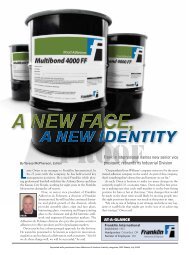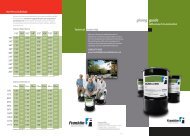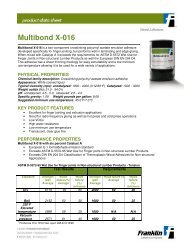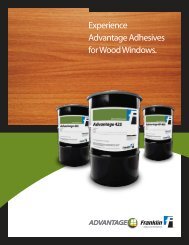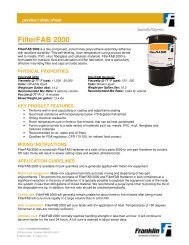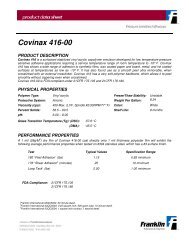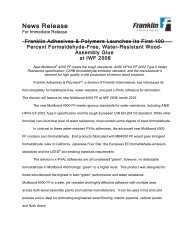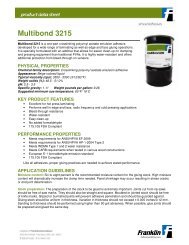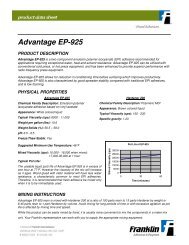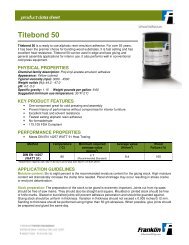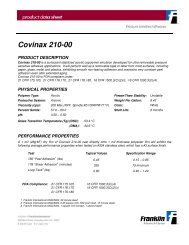Multibond X-016 - Franklin Adhesives and Polymers
Multibond X-016 - Franklin Adhesives and Polymers
Multibond X-016 - Franklin Adhesives and Polymers
Create successful ePaper yourself
Turn your PDF publications into a flip-book with our unique Google optimized e-Paper software.
APPLICATION GUIDELINES (Continued)<br />
Equipment Check: Be sure to check overall knife stack for accuracy. Keep cutterheads in pairs <strong>and</strong> properly cleaned.<br />
Cutterheads should be sharpened as a set. Knife set should cut only .3 mm to .8 mm of wood. Knives should be<br />
sharpened after running approximately 70 m³ (wood species may cause this to vary). Make sure cutterhead spindle is<br />
set vertically with no wear or play in the bearings. Chain carrier lugs should be squared with the trim saws <strong>and</strong><br />
cutterheads. Make sure trim saws are set true. Check bed rails for wear on a regular basis. Check hold down pressure<br />
to provide sufficient pressure to prevent movement of stock while cutting the joint.<br />
Joint Assembly: Pressure should be held constant until joint is cured. End pressure should be set to provide 10-14<br />
Kg/cm² pressure for non-structural joints. Crowder wheels should be aligned to match fingers accurately.<br />
Adhesive Application: Sufficient adhesive spread will provide a uniform coverage that should cover 1/2-2/3 the length<br />
of the finger on both sides in a thin continuous film. Make sure fingers aren't skipped <strong>and</strong> that the adhesive is applied<br />
to the whole joint, not just the tips of the fingers. Excess adhesive squeeze-out can cause arcing in a Radio Frequency<br />
tunnel. It also causes adhesive build-up <strong>and</strong> poor adhesive efficiency. Too much adhesive can cause a hydraulic effect<br />
in finger joint back off.<br />
PERFORMANCE PROPERTIES<br />
Meets or exceeds the following industry st<strong>and</strong>ards:<br />
• NWWDA 1.S. 1-87 Type I <strong>and</strong> Type II with Catalyst A<br />
• ANSI/HPMA 1994 Type I <strong>and</strong> Type II water resistance with Catalyst A<br />
• D-5572 Wet Use (Finger Joint)<br />
• European St<strong>and</strong>ard DIN EN 204 D4 (formerly DIN 68602 B4)<br />
• European E-1 formaldehyde emission st<strong>and</strong>ard<br />
ASTM D-905 Bond Strength (hard maple) 4 lb/in² Wood failure%<br />
25°C 3,720 34<br />
65°C Overnight 1,720 05<br />
Room Temperature Speed of Set 5 : 0.74 with Catalyst A. (Very Slow)<br />
EN 204 Durability Class D4 Performance:<br />
Conditioning Sequence<br />
Minimum value<br />
<strong>Multibond</strong> X-<strong>016</strong> (6%<br />
Catalyst A) WF %<br />
1 (7 d. cure tested dry) ≥ 10 15.3 N/mm² 100<br />
3 (7 d. cure, 4 d. H 2 0 soak; tested wet) ≥ 4 7.3 N/mm² 0<br />
5 (7 d. cure, 6 hr. boiling; 2 hr. cold H 2 0: tested wet) ≥ 4 5.2 N/mm² 0<br />
6 (7 d. cure, 6 hr. boiling; 2 hr. cold H 2 0; 7 d. dry tested dry) ≥ 8 13.7N/mm² 100



